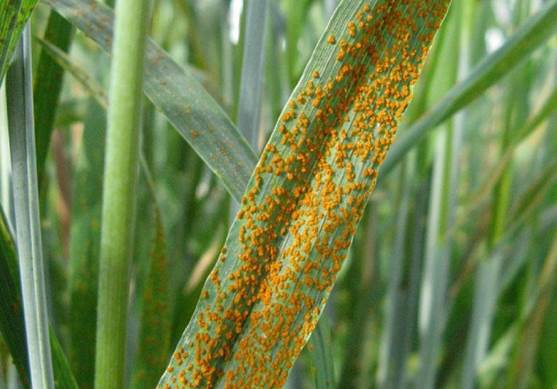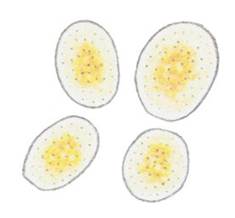
3.5 Leaf rust (Brown rust)
The pathogen responsible for the disease is the fungus Puccinia recondita Desm. (syn. - Puccinia tritici Eriks.).
It manifests primarily on the underside of leaves as small, rounded, ochre-brown pustules containing brown urediniospores (Figure 65). These are single-celled organisms, typically round or oval in shape, with a brownish outer coating and small spiny projections, measuring 20-28 micrometers (Figure 66). By the end of the growing season, shiny black pustules form on the underside of leaves, containing elongated, club-shaped, two-celled teliospores, with a thicker, light-brown upper cell.
The pathogen develops at temperatures ranging from 6 to 35 °C and relative humidity from 63 to 77%. At a temperature of 21 °C, sporulation is observed on the 6th day; at 16 °C - on the 10th day; and at 30-38 °C, the viability of urediniospores lasts up to three months. In autumn, telia with teliospores form on dying wheat leaves, which can withstand low temperatures (down to −30 to −40 °C). In spring, they germinate into a basidium with basidiospores, which infect an intermediate host - the wild wheat or wild rye. The urediniospores of the fungus germinate in liquid water at 18-25 °C within 2-3 hours and produce sprouts that penetrate through the leaf epidermis into the intercellular spaces. For plant infection, a brief rain or dew is sufficient. At an average daily temperature of 20-25 °C, the incubation period of the disease lasts 6-7 days; at 15-18 °C, it extends to 10 days (Geshele, 1955; Prikhodko, 1981; Elchibaev, 1972; Turapin, Elchibaev, 1972, 1981).

Figure 65 - Leaf rust (Brown rust) of wheat

Figure 66 - Urediniospores of the fungus P. recondita
Distribution and harmfulness. In the northeast of the republic, it develops to epidemic levels every 2-3 years. In Northeast Kazakhstan, brown rust and septoria often manifest together, with one disease predominating over the other.